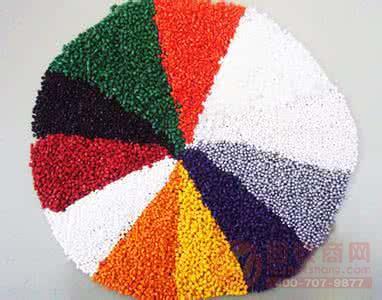Introduction to the production process of masterbatch

The masterbatch production process is very strict, and the wet process is generally used. The masterbatch is made by aqueous phase grinding, phase inversion, water washing, drying and granulation. Only the quality of the product can be guaranteed. In addition, the pigment should be subjected to a series of tests, such as measuring the fineness of the sanding slurry, measuring the diffusion performance of the sanding slurry, determining the solid content of the sanding slurry, and measuring the fineness of the colorant.
There are four ways to process the masterbatch production:
(1) Ink method: As the name implies, it is a production method using ink color paste in the production of masterbatch, that is, a three-roll mill is used to coat a surface of a pigment with a low molecular protective layer. The ground fine color paste is then mixed with a carrier resin, then plasticized by a two-roll mill (also called a two-roll mill), and finally granulated by a single-screw or twin-screw extruder.
The process is as follows:
Ingredient mixing coarse color paste three-roll grinding fine color paste two-roll plasticating extrusion granulation
(2) Flushing method: the pigment, water and dispersing agent are sanded to make the pigment particles smaller than 1 μm, and the pigment is transferred into the oil phase by a phase transfer method, and then dried to obtain a masterbatch. An organic solvent, as well as a corresponding solvent recovery unit, is required for phase inversion. The process is as follows:
Fine color paste rinse evaporation concentrate dry and added to the carrier extrusion granulation
(3) Pinch justification: After blending the pigment and the oily carrier, the pigment is immersed in the water phase by kneading. At the same time, the surface of the pigment is coated by an oil carrier to stabilize the dispersion of the pigment and prevent the pigment from agglomerating.
(4) Metal soap method: after the pigment is ground, the particle size reaches about 1 μm, and the soap liquid is added at a certain temperature, so that the surface layer of each pigment particle is evenly wetted by the soap liquid to form a saponification liquid. After the metal salt solution is added, it chemically reacts with the saponified layer on the surface of the pigment to form a protective layer of magnesium soap (magnesium stearate), so that the finely divided pigment particles do not cause flocculation, and the protection is certain. Fineness.
We diviided the led light according to the using eviiroment. Most of our product is the commercial LED Lighting
Commercial lighting is a term used to describe lighting that is used in commercial spaces, including auto dealerships, distribution centers, churches, factories, offices, and warehouses. Unlike residential lighting, commercial lighting is made to withstand more abuse and has a longer lifespan.
While the focus of residential lighting is often on aesthetics, commercial lighting is task orientated. Commercial lighting systems are designed based on what the application is. For example, in an office-type setting, you may see task lighting, which illuminates specific areas where employees need concentrated light to be able to perform their jobs.
Magnetic Track Light,Led Track Linear Light,Vertical Track Lighting,Black Kitchen Track Lighting
Jiangmen Dilin Lighting High-Tech Co., Ltd. , https://www.jmdilinled.com